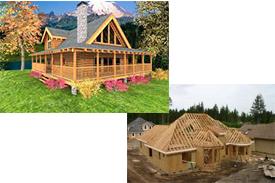 It’s human nature to compare various things: cats vs. dogs, Coke vs. Pepsi, men vs. women, etc. So, it comes as no surprise that we are often asked how log homes stack up (pardon the pun) against traditional stick-built homes. Our response? Both are great, but both types of homes come with their own set of advantages and disadvantages.
It’s human nature to compare various things: cats vs. dogs, Coke vs. Pepsi, men vs. women, etc. So, it comes as no surprise that we are often asked how log homes stack up (pardon the pun) against traditional stick-built homes. Our response? Both are great, but both types of homes come with their own set of advantages and disadvantages.
When talking about conventional homes, we are referring to those homes, which have been built using non-log or timber products. In other words, these homes have a basic 2×4 or 2×6 framing, onto which large sheets of OSB have been nailed. Brick, stucco, or vinyl siding is then used to give the home its finished exterior appearance.
The outward appearance of a home is very important. It often sets the tone for the interior of the home and can tell others about the preferences of the homeowner. For instance, a home whose exterior has brick or vinyl siding might tell people that the homeowner is very traditional. This home’s interior, most likely, is not “flashy” or extravagant, either. A home with a stucco exterior might have a more lavish appearance. The interior of the home may include “extras,” such as a fireplace or arched doorways. A log home is often viewed as a luxury, high value home. An outside observer would probably not be surprised to see a fireplace, great room, cathedral ceilings, and screened-in porches in such a home.
A conventional home can be adapted to fit into almost any neighborhood. Log homes are often built in neighborhoods consisting mainly of other log homes; or, they may stand by themselves, with few, if any, neighboring homes. Traditional homeowners might prefer to live in a home that requires very little exterior maintenance. Owners of log homes accept the responsibility of routine exterior maintenance as a means of protecting their investment. While this extra maintenance is usually quite simple, such as visually inspecting the home for mildew and checks, it is an added step many people do not wish to contend with.
Conventional homes often take longer to construct than log homes. In a conventional home, the building crew must construct each exterior wall before setting them in place. When building a log home, the log walls are stacked, meaning courses of logs are set one on top of another, until the desired wall height is achieved. This can save a considerable amount of time in the building process.
Log homes are often referred to as “green homes.” One reason is because these homes are made from logs, which are renewable resources. Traditional homes are framed using wood, also; however, the exterior of a traditional home is typically vinyl or brick, which, of course, are not renewable. Another reason log homes are seen as more environmentally friendly is because of the logs’ natural ability to absorb, store, and slowly release heat over time. This is referred to as “thermal mass.” Log walls naturally moderate temperature swings inside the home year-round, consequently reducing the amount of energy used to heat and cool the home. A very well-insulated conventional home may also be able to reduce energy use inside the home; however, insulation is not considered to be “green.”
One final point of comparison is the ease with which one can locate and purchase a pre-existing home. There is a much larger market for already-built, move-in ready conventional homes than exists for log homes. This is probably not a surprise. The number of traditional homes built over the years far exceeds that of log homes; therefore, the number of pre-existing traditional homes on the market each year will be far greater than the number of log homes available. Also, most log homes are custom-built and tailored to meet a particular homeowner’s specifications. Simply put, these homeowners build their dream house and do not move out.
Both conventional and log homes can be constructed with good craftsmanship. Both can reflect the unique qualities of its owner. Only you can decide which type of home is right for your family and lifestyle.

